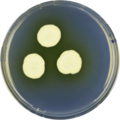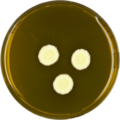| Aspergillus taichungensis | |
|---|---|
| Scientific classification | |
| Kingdom: | Fungi |
| Division: | Ascomycota |
| Class: | Eurotiomycetes |
| Order: | Eurotiales |
| Family: | Aspergillaceae |
| Genus: | Aspergillus |
| Species: | A. taichungensis |
| Binomial name | |
| Aspergillus taichungensis Yaguchi, Someya & Udagawa (1995) [1] | |
Aspergillus taichungensis is a species of fungus in the family Aspergillaceae.
A. taichyngensis was first described in 1995 and has been isolated from soil in Taiwan. [1] It was first described in 1995. The fungus is from the Candidi section, which is known for white spores. [2] It has been shown to produce candidusin C, terphenyllin, and 3-hydoxyterphenyllin. [2]
The genome of A. taichungensis was sequenced as a part of the Aspergillus whole genome sequencing project. The genome assembly size was 27.12 Mbp. [3]

